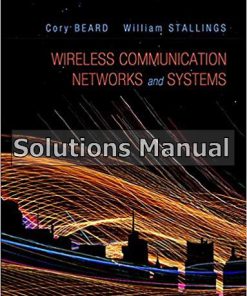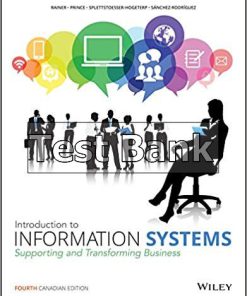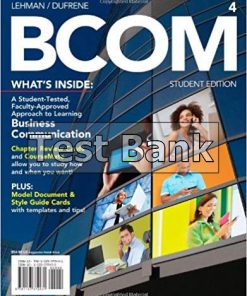Introduction to Wireless and Mobile Systems 4th Edition Agrawal Solutions Manual
$26.50$50.00 (-47%)
Introduction to Wireless and Mobile Systems 4th Edition Agrawal Solutions Manual.
You may also like
Instant download Introduction to Wireless and Mobile Systems 4th Edition Agrawal Solutions Manual pdf docx epub after payment.

Product details:
- ISBN-10 : 1305087135
- ISBN-13 : 978-1305087132
- Author:
1. INTRODUCTION. History of Cellular Systems. Characteristics of Cellular Systems. Fundamentals of Cellular Systems. Cellular System Infrastructure. Network Protocols. IEEE 802.11 Techniques. Ad Hoc Networks. Sensor Networks. Wireless LANs, MANs, and PANs. Security and Privacy in Wireless Networks. Satellite Systems. Recent Advances. Outline of the Book. References. Problems.
2. PROBABILITY, STATISTICS, AND TRAFFIC THEORIES. Introduction. Basic Probability and Statistics Theories. Traffic Theory. Basic Queuing System. Summary. References. Problems.
3. MOBILE RADIO PROPAGATION. Introduction. Types of Radio Waves. Propagation Mechanisms. Free Space Propagation. Land Propagation. Path Loss. Slow Fading. Fast Fading. Doppler Effect. Delay Spread. Intersymbol Interference. Coherence Bandwidth. Cochannel Interference. Summary. References. Experiments. Open-Ended Projects. Problems.
4. CHANNEL CODING AND ERROR CONTROL. Introduction. Linear Block Codes. Cyclic Codes. Cyclic Redundancy Check (CRC). Convolutional Codes. Interleaver. Turbo Codes. ARQ Techniques. Summary. References. Experiments. Open-Ended Projects. Problems.
5. CELLULAR CONCEPT. Introduction. Cell Area. Signal Strength and Cell Parameters. Capacity of a Cell. Frequency Reuse. How to Form a Cluster. Cochannel Interference. Cell Splitting. Cell Sectoring. Summary. References. Experiments. Open-Ended Projects. Problems.
6. MULTIPLE RADIO ACCESS. Introduction. Multiple Radio Access Protocols. Contention-Based Protocols. Comparison of CSMA/CD and CSMA/CA. Summary. References. Experiments. Open-Ended Projects. Problems.
7. MULTIPLE DIVISION TECHNIQUES FOR TRAFFIC CHANNELS. Introduction. Concepts and Models for Multiple Divisions. Modulation Techniques. Summary. References. Experiments. Open-Ended Projects. Problems.
8. TRAFFIC CHANNEL ALLOCATION. Introduction. Static Allocation versus Dynamic Allocation. Fixed Channel Allocation (FCA). Dynamic Channel Allocation (DCA). Hybrid Channel Allocation (HCA). Allocation in Specialized System Structure. System Modeling. Summary. References. Experiments. Open-Ended Projects. Problems.
9. MOBILE COMMUNICATION SYSTEMS. Introduction. Cellular System Infrastructure. Registration. Handoff Parameters and Underlying Support. Roaming Support. Multicasting. Ultra-Wideband Technology. Femtocell Network. Summary. References. Experiments. Open-Ended Problem. Problems.
10. NETWORK PROTOCOLS. Introduction. TCP/IP Protocol. TCP over Wireless. Internet Protocol Version 6 (IPv6). Summary. References. Experiment. Open-Ended Project. Problems.
11. EXISTING WIRELESS SYSTEMS. Introduction. AMPS. IS-41. GSM. PCS. IS-95. IMT-2000. Summary. References. Problems.
12. ACCESS POINTS AND VARIANTS. Introduction. Downlink Transfer of Information. Uplink Transfer of Information. Variants of 802.11 Series Protocol. Summary. References. Experiment. Open-Ended Project. Problems.
13. AD HOC NETWORKS. Introduction. Characteristics of MANETs. Applications. Routing. Table-Driven Routing Protocols. Source-Initiated On-Demand Routing. Hybrid Protocols. Multipath Routing Protocols. Vehicular Area Network (VANET). Network Simulators. Summary. References. Experiments. Open-Ended Project. Problems.
14. SENSOR NETWORKS. Introduction. Adapting to the Inherent Dynamic Nature of Wireless Sensor Networks. Functional Units of a Wireless Sensor Network. Sensing Area, Communication Range, and Sensor Placement. Randomly Deployed Sensor Networks. Placing Sensors at Fixed Locations. Network Characteristics. Hierarchical Routing in Sensor Networks. Design Issues in Sensor Networks. Summary. References. Experiments. Open-Ended Project. Problems.
15. WIRELESS LAN, PANS, BANS, AND MANS. Introduction. ETSI HiperLAN. HomeRF. Ricochet. Wireless Personal Area Networks (WPANs). IEEE 802.15.1 (Bluetooth). ZigBee. Wireless Body Area Networks. WMANs Using WiMAX. WMAN Using a Mesh Network. WMANs Using 3GPP and LTE. WMAN Using LTE and LTE-A. Summary. References. Experiments. Open-Ended Project. Problems.
16. SECURITY AND PRIVACY IN WIRELESS NETWORKS. Introduction. Cellular System Infrastructure. Wireless System Security. Firewalls and System Security. Security Issues in Mobile Ad Hoc Networks (MANETs). Secured Communication in Wireless Sensor Networks. DDoS Attack Detection. Summary. References. Experiments. Open-Ended Project. Problems.
17. SATELLITE SYSTEMS. Introduction. Types of Satellite Systems. Characteristics of Satellite Systems. Satellite System Infrastructure. Call Setup. Global Positioning System. A-GPS and E
911. Summary. References. Experiment. Open-Ended Project. Problems.
18. RECENT ADVANCES IN WIRELESS TECHNOLOGIES. Introduction. SIM Card. Push-to-Talk (PTT) Technology for SMS. RFID. Cognitive Radio. Mobility and Resource Management for Integrated Systems. Two-Tier Visual Sensor Network. Multimedia Services Requirements. Directional and Smart Antennas. Application of Coding in Wireless Multi-hop Networks. Delay Tolerant and Mobile Opportunistic Network. 5-G and Beyond. Low-Power Design. XML. Android, iPad, and iPod. Internet of Things (IoT), WoT, and Social Networking.
People Also Search:
what is wireless and mobile computing
what is wireless connectivity technology
introduction to wireless and cellular communications nptel assignment solutions
similarities and differences between bluetooth and wifi
introduction to wireless and mobile networks
wireless intranet
wireless mobile devices












